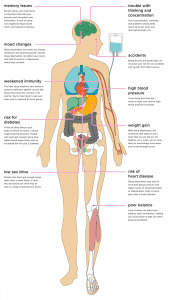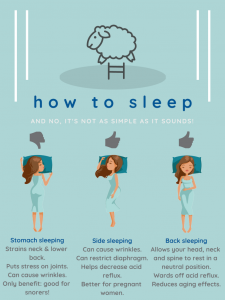Drink more water. Eat less sugar. Cut back seriously on caffeine, even though it’s Pumpkin Spice Latte season and the Starbucks sign is ever-tempting. You should be saving that money anyway, you know.
That stern little voice in my head reminds me constantly of the healthy habits I should follow more closely but more often shrug off in favor of instant gratification. No, I will splurge on that venti mocha macchiato with extra espresso, and barista, please don’t hold back on the mountain of whipped cream.
But when it comes to practicing good sleep hygiene, you may as well call me a pro. The CDC recommends that adults sleep for seven or more hours per night, and I happily adhere to these guidelines all year round (emphasis on “more”). I simply cannot, shall not, will not skimp on sleep. All you hyper-productive sleep deniers can pry those hours of slumber from my cold, dead, (unconscious) hands.
In case you don’t already know, there are tons of reasons to get gung-ho about a good night’s sleep. Research shows that sleep is essential to health in a number of different ways: it helps improve cognitive performance, cardiovascular functioning, emotional regulation, mood, and mental health, among other things. On the flip side, sleep deprivation is linked with various health problems including memory issues, concentration problems, weakened immunity, and risk of disease like high blood pressure and heart disease.
All this means that if you’re not currently prioritizing your sleep, you should start doing so yesterday. But here’s the tricky part: improving your sleep involves more than just tacking on an extra hour of shut-eye at the beginning or the end of the night. According to nationwide sleep research, it’s actually sleep quality – not quantity – that is the best predictor of positive health outcomes, both physical and psychological.
How To Improve Your Sleep Quality
Sleep quality, of course, refers to how restful and restorative your sleep is, and it’s measured by variables like how long it takes you to fall asleep, how often you wake up during the night, how many minutes you’re awake when you do wake up, and the amount of time you spend actually sleeping while you’re lying in bed. But the most important thing to know about sleep quality is what you can do to improve it.
We’ve all tried at least some of the top-ranking tips for better sleep: Stick to a schedule; nap sparingly; exercise, but not too close to bedtime; put the phone and computer screen away.
But did you know that sleeping on your side is also a key component of healthy sleep hygiene?
According to the Sleep Foundation, side sleeping (as opposed to sleeping on your back or stomach) conveys all sorts of health benefits, from reduced snoring and lower back pain to improved gut health and better brain functioning. Here, experts help to break down all the benefits, explain which side is generally best, and share tips to position yourself for your healthiest sleep yet.
The Science-Backed Benefits Of Side Sleeping
Ready, set, snooze! Here are five key health benefits of sleeping on your side, according to the experts:
- Reduces back and joint pain. “Side sleeping is beneficial to people suffering from lower-back issues, as it promotes spinal alignment and keeps the supporting muscles relaxed,” says Susan Miller, lead researcher and certified sleep technician at SleepMattressHQ.com. People with fibromyalgia are often advised to sleep in the fetal position to relieve tension in their muscles and joints.
- Reduces snoring. When you sleep on your back, your tongue can fall back into your mouth and partially obstruct your airway, leading to snoring and difficulty breathing (especially if you have obstructive sleep apnea). According to Jeff Kahn, sleep researcher and CEO of Rise Science, side sleeping helps to open the airway and relieve the symptom of snoring – which leads to better breathing during the night.
- Improves gut health. The digestive system is naturally located on the left side of the body – not in the center – so sleeping in this position helps food travel more seamlessly through the stomach and intestines. People who experience heartburn or acid reflux can especially benefit from side sleeping, Miller points out.
- Improves brain health. Side sleeping can improve the glymphatic system, the waste cleansing process in the brain. A glymphatic system that is impaired can lead to brain atrophy and, ultimately, neurological disorders like Alzheimer’s disease. Research has shown that people who sleep on their sides experience faster waste removal than those who sleep on their stomachs or backs.
- Improves blood flow. Some evidence suggests that side sleeping – particularly on the left side – can improve heart function and circulation. For this reason, Khan explains, side sleeping can often help those suffering from cramps, numbness, or swollen ankles. “It’s also the recommended position if you’re pregnant, because back sleeping has been shown to restrict blood flow for pregnant people,” he says.
The Best Side To Sleep On
So which side should you sleep on to reap the most bedtime benefits? In the words of the great Beyoncé, the answer is (generally) “to the left, to the left.”
“There’s evidence to suggest both sides aren’t equal and, in fact, the left side is best because it benefits systems and organs on the left side of the body: potentially reducing risk of acid reflux and heartburn, helping to detoxify the brain and body, and improving circulation,” says Kahn. “Right-side sleeping might even worsen heartburn because of the angle it puts your stomach in.”
That being said, if you’re seeking relief from back pain, snoring, or sleep apnea, the consensus is that even right-side sleeping is superior to lying on your stomach or back. So pick a side, any side, and wake up more refreshed.
Tips For Better Side Sleeping
Need an extra boost to keep you side-sleeping soundly? After you pick a side, pick a pillow…or a few, that is.
“Staying in place can be tricky, so use a firm pillow under your head and neck, and a body pillow behind you to keep you propped up,” Kahn recommends. “If you suffer from joint pain, a small pillow between the knees will help keep your spine aligned.”
Still, Khan says, your best chance of sleeping well throughout the night is to follow good sleep hygiene practices regularly – regardless of specific sleep position. “The most important behaviors for healthy sleep include regular wake and sleep times that allow you to meet your full sleep needs; lots of natural bright light exposure in the morning and very dim light conditions before bed; and respecting your unique cut-off times for your last big meal, caffeine, and alcohol,” he says.
Follow these wise words, and you’ll never wake up on the wrong side of the bed again.



